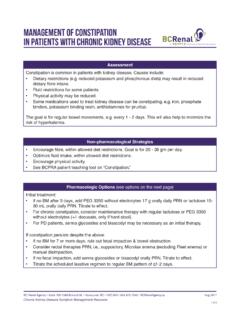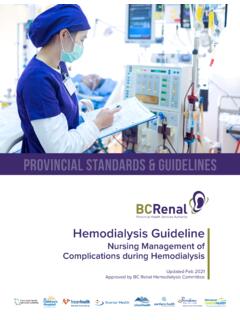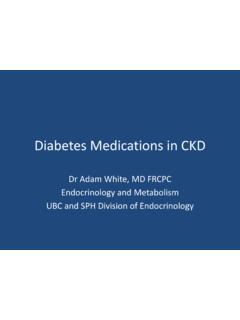Transcription of Management of PRURITUS in Patients with Chronic Kidney …
1 Management of PRURITUSin Patients with Chronic Kidney Disease 1 of 10BC Renal Agency Suite 700-1380 Burrard St. Vancouver, BC V6Z 2H3 Aug 2017 Chronic Kidney Disease Symptom Management ResourceAssessmentGeneral History Generalized PRURITUS Duration of PRURITUS Character of PRURITUS ( paroxysmal vs. continuous) Exacerbating and relieving factors Detailed drug history Treatments tried (prescription/over the counter, topical, oral etc.)Generalized PruritusNo primary lesions Rule out other causes of PRURITUS with no primary lesionsPrimary lesions present Consider referral to dermatologist for diagnosis and managementPruritus with no primary lesions - differential diagnosis: Renal PRURITUS Liver disease/cholestatic PRURITUS Hematologic PRURITUS (Iron deficiency anemia, Polycythemia vera) Malignancy (leukemia, Hodgkin and Non-Hodgkin lymphoma) Endocrine PRURITUS (thyroid disease, uncontrolled diabetes)Other considerations in dialysis Patients : Ensure dialysis adequacy Consider heparin allergy (patient could be switched to NS flush or citrasate dialysate/Na citrate lock solution) Consider changing dialyzer, tubing, dialysate (to ultra-pure dialysate fluid), PD solutionManagement of Dry Skin General Measures1.
2 Bathing recommendations: Fragrance-free sensitive skin bar soap ( Dove sensitive skin bar soap) Limit use of soap to axillae and groin/perineum Avoid excessive bathing or bathing with hot water2. Avoid wearing rough clothing, such as wool, over itchy Use mild detergent for clothes/sheets and rinse well. 4. Keep fingernails short and clean. Try not to rub or scratch the itchy Keep your house cool and humid, especially in the Topical emollients: Fragrance-free emollient* BID to TID and especially after bathing; OR Baby oil BID to TID; OR Menthol in emollient* BID to TID For localized PRURITUS : Consider Capsaicin cream, apply sparingly BID-QID (onset of action 2-4 weeks) Pramoxine 1% in emollient BID-TID PRN 7. Consider acupuncture*Suggested fragrance-free emollients: Cerave cream Cetaphil cream Lipikar Baume AP & cream Aveeno cream Glaxal base cream Cliniderm soothing cream Aquaphor ointment Vaseline ointmentConsider dermatology referral for Narrowband-UVB phototherapy 2-3x/week Oral antihistamine: Hydroxyzine, 10-25mg po QID PRN or Diphenhydramine 25 mg po QID PRN (watch for sedation) Gabapentin 100mg po HS, titrate by 100mg Q7days.
3 Maximum dose should be adjusted based on renal function and patient tolerance see drug monograph. Consider 50mg (compounded capsule) po HS as a starting dose in frail elderly &/or if eGFR < 15mL/min. Others: Pregabalin 25 mg PO HS*; titrate by 25 mg Q7days. Maximum dose should be adjusted based on renal function and patient tolerance see drug monograph. Sertraline, 25 mg po daily, max dose 75mg/d (especially if concomitant depression) If no contraindication, consider doxepin 10mg po hs; titrate by 10 mg Q7days up to 50mg po hs (watch for QT prolongation) Go to (Health Professionals > CKD) for information on costs of medications and whether coverage may be available through BCPRA, Pharmacare or Palliative Care benefit of 10 Supplemental Evidence for Treatment OptionsIn terms of non-pharmacological therapies: Moisturizing cream should be considered for all Chronic Kidney disease (CKD) and dialysis Patients as xerosis is prevalent in this population.
4 Lotions are not recommended (the higher concentrations of emulsifiers and stabilizers and the lower concentration of lipid in lotions can further worsen dry skin). Other non-drug measures, minimizing the use of soap and hot bath, should also be considered. The successful use of behavioral therapy or habit reversal techniques has been reported in Patients with Chronic PRURITUS ; however, their utility in the CKD population has not been studied. We are not recommending steroid based cream or ointment for uremic PRURITUS , unless the patient has an inflammatory skin condition. Patients with renal PRURITUS typically have intense PRURITUS with no primary lesions. If the patient has primary lesions, a dermatology consultation should be considered for diagnosis and appropriate Management . A dermatology consult should be considered early for narrow band ultraviolet B (NB-UVB) phototherapy in severe or difficult-to-treat cases.
5 Several locations in British Columbia are available with phototherapy terms of pharmacotherapies, available literature in CKD non-dialysis Patients is limited, with only 4 publications on the Most of the pharmacotherapy options suggested in the algorithm have been trialed in hemodialysis (HD) Patients . Furthermore, published studies for both populations are of small sample size, from single centres, and have significant drop-out rates or crossover design with a short washout period. Although there are minimal data confirming the efficacy of sedating antihistamines in the treatment of PRURITUS in CKD Patients , they have historically been used as first-line agents for this indication. Efficacy data regarding non-sedating antihistamines are scarce and contradictory. A negative study comparing loratadine to naltrexone reported loratadine to decrease VAS (visual analogue scale) score in PRURITUS but this is likely not clinically significant and none of the Patients had a decrease in the VAS score > 3 points while receiving this Another study compared desloratadine to gabapentin during a cross-over trial in 22 HD Patients .
6 While taking desloratadine 5 mg po 3 times/week, Patients VAS score decrease to a similar extent than while taking gabapentin 300 mg po 3 times/week therapy, with less adverse reactions reported in the desloratadine Most experts do not recommend non-sedating antihistamine in alleviating PRURITUS in CKD Patients as they do not cross the blood brain barrier, and therefore may be unable to affect the perception of itch. Due to the lack of confirmatory studies, the agents listed under limited evidence are not included in the treatment algorithm but could be considered if other typical more cost-effective agents fail. Management of PRURITUSin Patients with Chronic Kidney Disease BC Renal Agency Suite 700-1380 Burrard St. Vancouver, BC V6Z 2H3 Aug 2017 Chronic Kidney Disease Symptom Management Resource3 of 10 Positive StudiesNarrow band UVBA prospective study of 42 HD Patients with renal PRURITUS compared with a matched control group (n=21 in each group) to test the efficacy of NB-UVB was conducted in a hospital in Taipei, Taiwan.
7 The intervention group received NB-UVB 3x/week for 2 weeks and control group was maintained on their prior PRURITUS treatment. PRURITUS intensity was measured with a numerical rating scale at baseline and on alternating days for seven times. The intervention group had significantly lower PRURITUS intensity than the control group: (p< ) at time seven, (p< ) at time six and at time five (p< ).7 Another study investigated whether or not NB-UVB phototherapy is an effective treatment for uremic PRURITUS . A single-blind, randomized (1:1), controlled trial for Patients (n=21; 14 HD and 3 PD) with refractory uremic PRURITUS was conducted where the treatment group received NB-UVB 3x/week for 6 weeks and control group received time-matched exposures to long-wave UVA radiation for 12 weeks. The characteristics of PRURITUS were assessed at baseline and after 6 weeks of phototherapy.
8 NB-UVB and control groups both had improvement in PRURITUS intensity. Compared to the control group, the NB-UVB group showed a significant improvement in the involved body surface area affected by PRURITUS (p= ) but not in sleep quality. Patients in the NB-UVB group has lower PRURITUS intensity scores at week 6, 10 and 12 which may indicate a beneficial difference at certain time points but the effect was marginal overall. This study concludes that NB-UVB phototherapy does not show a significant effect in reducing PRURITUS intensity compared with the control A pilot study of NB-UVB phototherapy was conducted for the treatment of 20 Patients (n=20) with uremic PRURITUS . Ten Patients (10 Patients left the study) completed the 6-week study period with treatment 3x/week. Eight Patients were responders. Of the 10 Patients that did not complete the study, 6 were satisfied with the response.
9 In the follow-up period at 6 months post-treatment, 7 responders were assessed and 3 were in remission; however, PRURITUS recurred in the remaining 4. NB-UVB may be an effective treatment but recurrence of PRURITUS is a A meta-analysis of UVB trials for uremic PRURITUS was conducted using only randomized control trials available on MEDLINE from 1966 to March 1991. Clinically significant outcomes were obtained for 2 of 3 whole-body UVB trials. Meta-analysis of the UVB trials retained the significant effect in analysis of proportions of Patients improving under this intervention (pooled odds ratio 18; 95% confidence interval 4 to 161). Trials of lidocaine, charcoal and nicergoline demonstrated either statistically significant improvement in PRURITUS score or in proportions, but not both. UVB phototherapy was found to be the treatment of choice in moderate to severe uremic Another study evaluated the effect of UV phototherapy on uremic PRURITUS in 56 Patients with Chronic Kidney disease (52 on HD, 4 PD).
10 Seven Patients (n=7) were treated 2x/week for 4 weeks with UVB to of the body and placebo phototherapy (UVA) to the other half. All Patients noted generalized improvement without localization of benefit to the UVB side. Patients treated more frequently (3x/weekly) improved faster. Overall, 32 of 38 Patients improved after a course of 6 or 8 UVB exposures. PRURITUS recurred in 15 Patients after a mean remission of 3 months. Sixteen Patients remained in remission for months after the 1st or 2nd BC Renal Agency Suite 700-1380 Burrard St. Vancouver, BC V6Z 2H3 Aug 2017 Chronic Kidney Disease Symptom Management Resource4 of 10course of Baby oil (topical)A prospective study of 35 HD Patients with PRURITUS compared with a matched control group (n=35) looked at the efficacy of cool baby oil (10-15 ) applied on the affected area for 15-20 minutes 3 times/week prior to HD for 1 Baby oil improved VAS PRURITUS score, the Pittsburgh sleep quality index as well as the SF-36 Quality of life Physical and Mental component scores.









